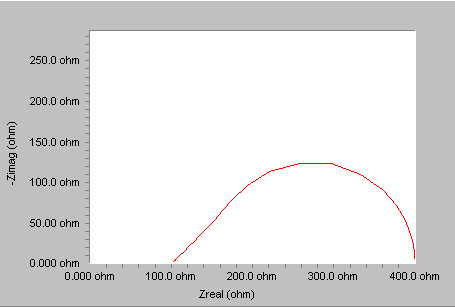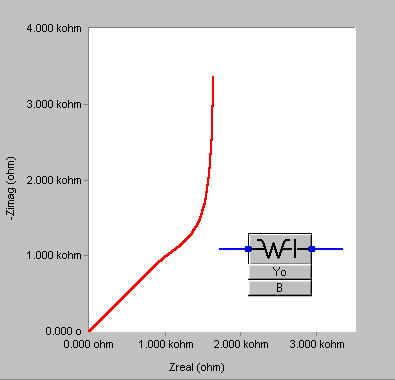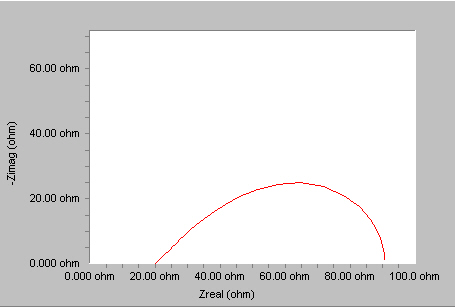Description
Diffusion can create an impedance known as the Warburg impedance, which depends on the frequency of the potential perturbation. At high frequencies, the Warburg impedance is small because diffusing reactants don't have to move very far. At low frequencies, the reactants have to diffuse farther, thereby increasing the Warburg impedance.
Infinite Warburg impedance
The equation for the Infinite Warburg ZW impedance is:
with the radial frequency ω (s-1) and the Warburg coefficient σ. On a Nyquist plot, the Warburg impedance appears as a diagonal line with a slope of 0.5. On a Bode plot, the Warburg impedance exhibits a phase shift of 45°.
The Warburg coefficient σ is defined as:
with the diffusion coefficients of the oxidant DO and reductant DR in cm2/s, the bulk concentration of the oxidant and reductant in mol/cm3, surface area A of the electrode in cm2, and number n of electrons involved.
The equation for the Warburg impedance can also be written as:
with
This form of the Warburg impedance is only valid if the diffusion layer has an infinite thickness. Quite often, however, this is not the case.
Porous Bounded Warburg impedance
If the diffusion layer is bounded (as in thin-layer cell or coated samples), the impedance at lower frequencies no longer obeys the equation above. Instead, we get the form:
with
δ is the Nernst diffusion layer thickness (in cm) and D the average value of the diffusion coefficients of the diffusing species. This more general equation is called the Finite or Porous Bounded Warburg impedance. You may see this referred to as an "O" circuit element. For high frequencies where , or for an infinite thickness of the diffusion layer where , the previous equation simplifies to the infinite Warburg impedance. A Nyquist plot for a Porous Bounded Warburg is shown below.

Nyquist plot with a Porous Bounded Warburg element.
Common examples of a Porous Bounded Warburg are diffusion to a rotated disk electrode or the diffusion of oxygen through a thin coating. Parameters used for fitting this element are Y0 in siemens and B in .
Bounded Warburg impedance
Another variation of the Warburg is the Bounded Warburg. You may see this referred to as a "T" circuit element. The Bounded Warburg describes a diffusion process totally within a thin slice of solution or a thin slice of material. Common examples are a conducting polymer membrane or a supercapacitor (an "Electrochemical Capacitor").
For high frequencies where , or for an infinite thickness of the diffusion layer where , the previous equation also simplifies to the infinite Warburg impedance. A Nyquist plot is shown below. Parameters used for fitting this element are Y0 in siemens and B in .

Nyquist plot with a Bounded Warburg element.
Gerischer impedance
One other element is the Gerischer Impedance (G). Its impedance is given by
Parameters used for fitting this element are Y0 in siemens and KA in s-1. A sample plot is shown below.

Nyquist plot with a Gerischer element.